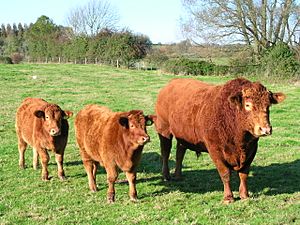South Devon cattle facts for kids
The South Devon is a large and friendly breed of beef cattle from England. It's the biggest of all the native British cattle breeds! People think it came from large red cattle brought over from Normandy during the Norman invasion of England. South Devons have a beautiful rich, medium red coat with copper hints. They are mostly raised for their beef, but long ago, they were also used for milk. A special group called The South Devon Herd Book Society was started in 1891 to help manage and promote the breed.
Contents
A Look Back: South Devon Cattle History
The South Devon cattle are believed to have come from large red cattle from Normandy. These cattle were brought to England during the Norman invasion. The breed first developed in South West England, in a part of Devon called the South Hams. From there, they spread across Devon and into Cornwall.
For a long time, the South Devon and North Devon breeds grew apart. This happened because they were kept separate. However, sometimes they would still crossbreed until the mid-1800s.
How the Breed Developed
By the year 1800, the South Devon was a well-known breed. These cattle had a light red coat and were very strong. They gave rich milk and good quality beef. Their beef was known for being finely grained and marbled. For many years, even into the 1800s, these powerful cattle were used to pull ploughs on farms.
Farmers carefully chose the best animals for breeding. This helped to make the breed even better. In 1891, the South Devon Herd Book Society was officially recognized by the government. This made the South Devon one of the first fourteen cattle breeds to have its own official record book.
From Milk to Beef
In the early 1900s, the South Devon was considered a "dual-purpose" breed. This means they were used for both milk and beef production. Many farms milked their South Devon cows, especially during and after the Second World War.
However, since the 1960s, farmers have focused more on breeding them for beef. Today, the South Devon is mainly a beef breed. But because of their history, the cows are still very good at feeding their calves.
South Devons Around the World
South Devon cattle can adapt very well to different weather conditions. This is why they are now found on five different continents! Wherever they have been introduced, these cattle have been well-liked. They have shown strong results for production and making a profit.
South Devons in Australia
South Devons were one of the few British breeds used for pulling carts, as well as for beef and milk. The first South Devon milking cows arrived in Australia on sailing ships. Many large groups of these cattle were brought over in the late 1800s and early 1900s. However, the breed later lost its pure identity due to crossbreeding.
New purebred South Devons were brought from Britain in 1969. The first purebred animals from New Zealand arrived in 1971. Today, you can find South Devon cattle in most states of Australia.
South Devons in the United States
The first South Devon cattle were brought to the United States in 1969. In 1974, the North American South Devon Association was created. This group helps to develop, register, and promote the South Devon breed in the United States.
What Makes Them Special?
South Devon cattle have some unique features that make them stand out.
Reproduction and Growth
Female South Devons mature early. They can have their first calf when they are two years old. However, it's also common for them to calve at 2.5 to 3 years. A mother cow can have a calf every year for up to 15 years! Pregnancy usually lasts about 286 days. Most births are single calves, but about 10% of the time, twins are born.
Male South Devons, called bulls, grow very quickly. They also mature early and can start fathering calves around 15 to 18 months old. Bulls can continue to work until they are about 12 years old. A fully grown bull can weigh between 1,200 and 1,600 kilograms (about 2,600 to 3,500 pounds). The largest South Devon ever recorded weighed an amazing 2,000 kilograms (about 4,400 pounds)! That's as heavy as a small car!
Images for kids
-
Bull, photograph by Frank Babbage from the Encyclopædia Britannica, 1911
-
Bull at Amberley in West Sussex






